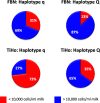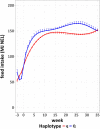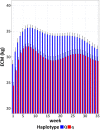Characterization of functional traits with focus on udder health in heifers with divergent paternally inherited haplotypes on BTA18
- PMID: 31296208
- PMCID: PMC6624885
- DOI: 10.1186/s12917-019-1988-4
Characterization of functional traits with focus on udder health in heifers with divergent paternally inherited haplotypes on BTA18
Erratum in
-
Correction to: Characterization of functional traits with focus on udder health in heifers with divergent paternally inherited haplotypes on BTA18.BMC Vet Res. 2019 Aug 8;15(1):285. doi: 10.1186/s12917-019-2034-2. BMC Vet Res. 2019. PMID: 31395056 Free PMC article.
Abstract
Background: A major challenge in modern medicine and animal husbandry is the issue of antimicrobial resistance. One approach to solving this potential medical hazard is the selection of farm animals with less susceptibility to infectious diseases. Recent advances in functional genome analysis and quantitative genetics have opened the horizon to apply genetic marker information for efficiently identifying animals with preferential predisposition regarding health traits. The current study characterizes functional traits with a focus on udder health in dairy heifers. The animals were selected for having inherited alternative paternal haplotypes for a genomic region on Bos taurus chromosome (BTA) 18 genetically associated with divergent susceptibility to longevity and animal health, particularly mastitis.
Results: In the first weeks of lactation, the q heifers which had inherited the unfavorable (q) paternal haplotype displayed a significantly higher number of udder quarters with very low somatic cell count (< 10,000 cells / ml) compared to their paternal half-sib sisters with the favorable (Q) paternal haplotype. This might result in impaired mammary gland sentinel function towards invading pathogens. Furthermore, across the course of the first lactation, there was indication that q half-sib heifers showed higher somatic cell counts, a surrogate trait for udder health, in whole milkings compared to their paternal half-sib sisters with the favorable (Q) paternal haplotype. Moreover, heifers with the haplotype Q had a higher feed intake and higher milk yield compared to those with the q haplotype. Results of this study indicate that differences in milk production and calculated energy balance per se are not the main drivers of the genetically determined differences between the BTA18 Q and q groups of heifers.
Conclusions: The paternally inherited haplotype from a targeted BTA18 genomic region affect somatic cell count in udder quarters during the early postpartum period and might also contribute to further aspects of animal's health and performance traits due to indirect effects on feed intake and metabolism.
Keywords: BTA18; Bovine mastitis; Clinical performance; Genetic selection; Somatic cell score (SCS).
Conflict of interest statement
The authors declare that they have no competing interests.
Figures





Similar articles
-
Cows selected for divergent mastitis susceptibility display a differential liver transcriptome profile after experimental Staphylococcus aureus mammary gland inoculation.J Dairy Sci. 2020 Jul;103(7):6364-6373. doi: 10.3168/jds.2019-17612. Epub 2020 Apr 16. J Dairy Sci. 2020. PMID: 32307160
-
Genetic selection for bovine chromosome 18 haplotypes associated with divergent somatic cell score affects postpartum reproductive and metabolic performance.J Dairy Sci. 2019 Nov;102(11):9983-9994. doi: 10.3168/jds.2018-16171. Epub 2019 Sep 11. J Dairy Sci. 2019. PMID: 31521359
-
Comparative expression profiling of E. coli and S. aureus inoculated primary mammary gland cells sampled from cows with different genetic predispositions for somatic cell score.Genet Sel Evol. 2011 Jun 24;43(1):24. doi: 10.1186/1297-9686-43-24. Genet Sel Evol. 2011. PMID: 21702919 Free PMC article.
-
Symposium review: Novel strategies to genetically improve mastitis resistance in dairy cattle.J Dairy Sci. 2018 Mar;101(3):2724-2736. doi: 10.3168/jds.2017-13554. Epub 2018 Jan 10. J Dairy Sci. 2018. PMID: 29331471 Review.
-
[Importance of estrogens and estrogen-active compounds for udder health in cattle. A review].Dtsch Tierarztl Wochenschr. 2003 Nov;110(11):461-5. Dtsch Tierarztl Wochenschr. 2003. PMID: 14679840 Review. German.
Cited by
-
Hepatic Transcriptome Analysis Identifies Divergent Pathogen-Specific Targeting-Strategies to Modulate the Innate Immune System in Response to Intramammary Infection.Front Immunol. 2020 Apr 29;11:715. doi: 10.3389/fimmu.2020.00715. eCollection 2020. Front Immunol. 2020. PMID: 32411137 Free PMC article.
-
Cows with diverging haplotypes show differences in differential milk cell count, milk parameters and vaginal temperature after S. aureus challenge but not after E. coli challenge.BMC Vet Res. 2024 May 15;20(1):200. doi: 10.1186/s12917-024-03996-y. BMC Vet Res. 2024. PMID: 38745199 Free PMC article.
-
In vivo model to study the impact of genetic variation on clinical outcome of mastitis in uniparous dairy cows.BMC Vet Res. 2020 Jan 31;16(1):33. doi: 10.1186/s12917-020-2251-8. BMC Vet Res. 2020. PMID: 32005239 Free PMC article.
-
Allele-biased expression of the bovine APOB gene associated with the cholesterol deficiency defect suggests cis-regulatory enhancer effects of the LTR retrotransposon insertion.Sci Rep. 2022 Aug 5;12(1):13469. doi: 10.1038/s41598-022-17798-5. Sci Rep. 2022. PMID: 35931741 Free PMC article.
-
Genomic and Phenotypic Udder Evaluation for Dairy Cattle Selection: A Review.Animals (Basel). 2023 May 9;13(10):1588. doi: 10.3390/ani13101588. Animals (Basel). 2023. PMID: 37238017 Free PMC article. Review.
References
-
- BMEL: Bundesministerium für Ernährung und Landwirtschaft. https://www.bvl.bund.de/DE/08_PresseInfothek/01_FuerJournalisten_Presse/.... Accessed 22 Nov 2018.
-
- Shea KM. Antibiotic resistance: what is the impact of agricultural uses of antibiotics on children’s health? Pediatrics. 2003;112(1 Pt 2):253–258. - PubMed
MeSH terms
Grants and funding
LinkOut - more resources
Full Text Sources

